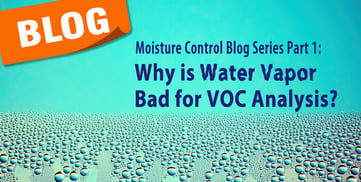
Analyzing volatile organic compounds (VOCs) is an essential part of environmental monitoring, flavor and fragrance analysis, and analysis in the pharmaceutical and petrochemical industries. Gas Chromatograph (GC) columns and detectors, namely Mass Spectrometers (MS), do not perform well in the presence of water. Before the sample is introduced to the GC, it must become a vapor.
For this reason, there are many samples, such as
pollutants in soil or flavors in solid food, that cannot be directly introduced into a GC. Purge and Trap (P&T) is the technique applied to separate and concentrate VOCs from sample matrices, including water or soil, before detection via GC-MS of sub-parts per billion (ppb) levels. Teledyne Tekmar has focused a large amount of effort on improvements to our moisture control by creating an improved moisture control fitting on the Atomx XYZ and Lumin.
P&T encourages a greater migration of VOCs from the liquid or solid phase into the gaseous or vapor phase, which can include water from the sample. This can introduce a tremendous amount of water vapor into the GC-MS. This water vapor can affect almost every part of the GC, from the injector to the column and all the way to the MS, which can impact analyte resolution and sensitivity.
Water vapor is bad for VOC analysis for a number of reasons. The water peak will minimize the sensitivity of our early eluting compounds, including gases that come off the GC column first, usually with the water vapor created by P&T analysis. Gases are hard to analyze as it is, so when their sensitivity is reduced even more by water vapor, analysis becomes that much more difficult.
Water vapor causes compounds to co-elude and shift in retention time. Therefore, from one sample to the next, compounds are moving around. This makes analysis harder. Water vapor can also cause poor peak shape, even in compounds outside of the water peak. Once the water vapor is introduced into our system, it starts to wreak havoc on all of our compounds. Water vapor may drastically reduce the lifetime of the GC column and adversely affect the MS performance by causing vacuum issues. This could lead to shorter MS filament lifetime and the need to clean the source more often.
So, how do we deal with this water vapor? On the P&T side, you want to make sure you’re using the correct trap for the method you’re running. Check your sample purge temperature. Purging the sample at higher temperatures by using a sample heater can drive VOCs out of solution more efficiently, but can also create additional water vapor. Other method parameters to consider would be dry purge and desorb settings. Dry purge settings may not by optimized as there is too much desorb time, or the sample may be desorbing at the wrong temperature. All these factors could be adding more water vapor to the analysis.
On the GC side of things, we can look at the split ratio. If the split ratio is set too low, it could be allowing too much water vapor to get onto the column. A long water peak may be a sign of a bad column or that it is time to replace the column. Finally, if the MS doesn’t have adequate vacuuming, then that water vapor is getting into the MS and causing more problems than it otherwise would.
This blog series will give you tips to optimize moisture control in the P&T and will dive deep into topics including trap selection, sample purge temperature, dry purge settings, desorb settings, and bake settings. We’ll also explore some parameters on the GC-MS that can optimize moisture control as well.